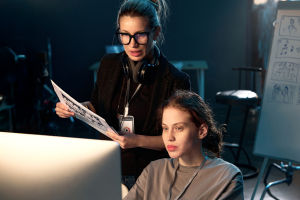Have you ever watched a movie and thought, "How did they create this magic?"
While the story and special effects play a huge role in bringing a film to life, there's another crucial element that often goes unnoticed—the collaboration between the director and the actors.
It's the harmony between the two that can elevate a good film into a classic.
When a director and actor form a seamless partnership, the results can be nothing short of spectacular. But how do they work together? What is the secret sauce that makes their relationship so impactful?
The Director's Vision
Every film begins with a vision. Directors are the creative force behind this vision, and their job is to bring the script to life. A director's role isn't just about telling the story—they are also responsible for shaping the overall tone, pacing, and visual style of the film. They have a clear idea of the kind of performance they want from their actors, but the challenge is translating that idea into reality.
Great directors know how to communicate their vision in a way that inspires actors to deliver their best performances. This communication doesn't just happen during rehearsals or on set; it's an ongoing process. Directors use different techniques—such as blocking scenes, giving specific line deliveries, and adjusting the pacing of a scene—to ensure that the emotions and themes of the film are conveyed precisely the way they envision it.
The Actor's Craft: Bringing Depth to the Story
While the director sets the stage, it's the actors who bring the characters to life. A great actor doesn't just memorize lines—they embody the role. The best performances often come from actors who have a deep understanding of their characters' motivations, emotions, and inner conflicts. This is where the director-actor collaboration becomes essential. A director helps guide the actor's performance, but the actor's creativity and emotional investment make that performance memorable.
Creating a Shared Language
To truly collaborate, the director and actor must speak the same creative language. This doesn't mean just sharing technical terms or film jargon. It's about understanding the emotional undertones of a scene, the subtleties of character development, and the pacing of the story. When this shared understanding is in place, actors can confidently push boundaries and try new approaches, knowing that their director will guide them to the right outcome.
Some directors are more hands-on, providing a lot of guidance and feedback, while others prefer to give their actors space to explore and interpret the role on their own.
The Importance of Trust and Chemistry
Trust and chemistry are the bedrock of the director-actor relationship. Without trust, the actor may hesitate to take the risks necessary for an outstanding performance. Without chemistry, the connection between characters can feel forced and lack authenticity. It's about creating a space where actors feel comfortable offering their own interpretations, where they can bring personal experiences into the role. Many directors encourage improvisation, as it can lead to moments of pure magic that cannot be planned. These spontaneous moments are often what make films feel real and emotionally powerful.
A Symbiotic Relationship
In the world of filmmaking, the collaboration between directors and actors is essential for creating truly remarkable cinema. It's a delicate dance, where the director sets the tone, but the actor brings the soul. When these two forces come together, the result is a film that resonates with audiences on an emotional and intellectual level. For us as viewers, these collaborations allow us to experience a movie in its truest form, with every character feeling authentic and every scene rich with meaning.
So, next time you watch a film that moves you, take a moment to think about the behind-the-scenes magic. Remember that directors and actors are not just creating characters—they're crafting moments of unforgettable cinematic history together.


